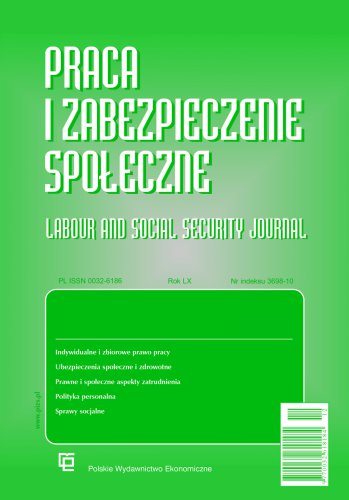Exposure to social risk versus trust in Social Security Institution, knowledge about social insurance and supplementary old-age saving
Reducing individuals' exposure to social risks is desirable from an individual and state perspective. A key factor determining the level of protection against the effects of social risks is the form of employment. The aim of this article is to indicate whether individuals with a lower level of protection in the social security system are characterised by lower trust in the Social Security, a more individualistic life attitude, or a lower level of knowledge about the pension system - and whether weaker protection is accompanied by compensatory measures. The answer to these questions is made possible by a statistical analysis based on individual data from the ZUS survey Knowledge and attitudes towards social security. In its light, those with the highest level of protection are also those with the highest level of knowledge about the mechanisms of the security system, while those with the highest or lowest level of protection are characterised by a slight dominance of communal over individualistic attitudes. Trust in ZUS is not statistically significantly different between groups with different levels of protection. Among compensation activities, voluntary saving is clearly more frequently recorded among those with low trust in ZUS, while the episode of working abroad was more frequent among those with above-average levels of knowledge. In selected subgroups, gaps in social security that could be compensated by public policy are revealed.
References
Behrendt, Ch., Nguyen Q.A. (2018). Innovative approaches for ensuring universal social protection for the future of work. Międzynarodowa Organizacja Pracy, Genewa. https://www.ilo.org/wcmsp5/groups/public/---dgreports/---cabinet/documents/publication/wcms_629864.pdf.
Buchholtz, S., Szczepański, M. (2022). Deklarowane powody nieoszczędzania na emeryturę w świetle ogólnopolskich badań ankietowych. Polityka Społeczna, 49(7), 1–9.
De Neubourg, C., Weigand, C. (2000). Social policy as social risk management. Innovation: The European Journal of Social Science Research, 13(4), 401–412.
Główny Urząd Statystyczny (2021). Wybrane aspekty rynku pracy w Polsce. Aktywność ekonomiczna ludności przed i w czasie pandemii COVID-19. Główny Urząd Statystyczny, Warszawa.
Jończyk, J. (2006). Prawo zabezpieczenia społecznego, Kantor Wydawniczy Zakamycze.
Kowalewski, E. (1998). Ryzyko w działalności człowieka i możliwości jego ograniczania. W: T. Sangowski (Red.), Ubezpieczenia gospodarcze. Poltext.
Księżopolski, M. (1985). Bezpieczeństwo społeczne i jego zagrożenia. W: A. Piekara, J. Supińska (Red.), Polityka społeczna w okresie przemian. Polskie Wydawnictwo Ekonomiczne.
Leksykon Polityki Społecznej (2001). Rysz-Kowalczyk E. (Red.), Oficyna Wydawnicza ASPRA-JR.
Łyskawa, K. (2007). Grupowe ubezpieczenia na życie z funduszem kapitałowym w systemie zabezpieczenia emerytalnego w Polsce. Fundacja Warty i Kredyt Banku „Razem możemy więcej”.
Międzynarodowa Organizacja Pracy. (1933). Invalidity, Old-Age and Survivors' Insurance Recommendation, 1933 (No. 43) https://www.ilo.org/dyn/normlex/es/f?p=NORMLEXPUB:55:0::NO::P55_TYPE,P55_LANG,P55_DOCUMENT,P55_NODE:REC,en,R043,/Do cument.
Międzynarodowa Organizacja Pracy. (1944). Income Security Recommendation, 1944 (No. 67), https://www.ilo.org/dyn/normlex/en/ f?p=1000:12100:::NO:12100:P12100_INSTRUMENT_ID:312405
Międzynarodowa Organizacja Pracy. (1952). Social Security (Minimum Standards) Convention, (No. 102), https://www.ilo.org/dyn/normlex/en/ f?p=NORMLEXPUB:12100:0::NO::P12100_ILO_CODE:C102.
OECD. (2020a). Taxing Wages 2020, OECD Publishing, Paris.
OECD, (2020b). Pension Markets in Focus 2020, OECD Publishing, Paris. https://www.oecd.org/daf/fin/private-pensions/Pension-Markets-in-Focus2020.pdf#:~:text=PENSION%20MARKETS%20IN%20FOCUS%202020%20%C2%A9%20OECD%202020,%28USD%201.1%20trillion%2C %202.3%25%20of%20OECD%20pension%20assets%29.
Pieters, D. (2000). Social Security: A Human Right in Search of A New Generation of International Legal Instruments, materiał z międzynarodowego sympozjium "Unemployment and Poverty – Causes and Remedies", Rzym, 5–10 września 2000.
Rutecka, J. (2012). Zakres redystrybucji dochodowej w ubezpieczeniowym systemie emerytalnym. Oficyna Wydawnicza SGH.
Stańko, D. (2005). Efektywność finansowania kapitałowego w bazowym systemie emerytalnym, praca doktorska, Szkoła Główna Handlowa w Warszawie.
Szarfenberg, R. (2008). Krytyka i afirmacja polityki społecznej, Wydawnictwo Instytutu Polityki Filozofii i Socjologii PAN, II wydanie.
Szumlicz, T. (1994). Modele polityki społecznej, Oficyna Wydawnicza Szkoły Głównej Handlowej w Warszawie.
Szumlicz, T. (2005). Ubezpieczenie społeczne. Teoria dla praktyki, Oficyna Wydawnicza Branta.
Zakład Ubezpieczeń Społecznych (2016). Wiedza i postawy wobec ubezpieczeń społecznych: raport z badań. Zakład Ubezpieczeń Społecznych, Warszawa, https://www.zus.pl/documents/10182/44573/Raport+wiedza+system+emerytalny/040bd2a1-094a-4d97-9d77-e0bddc19e845.

